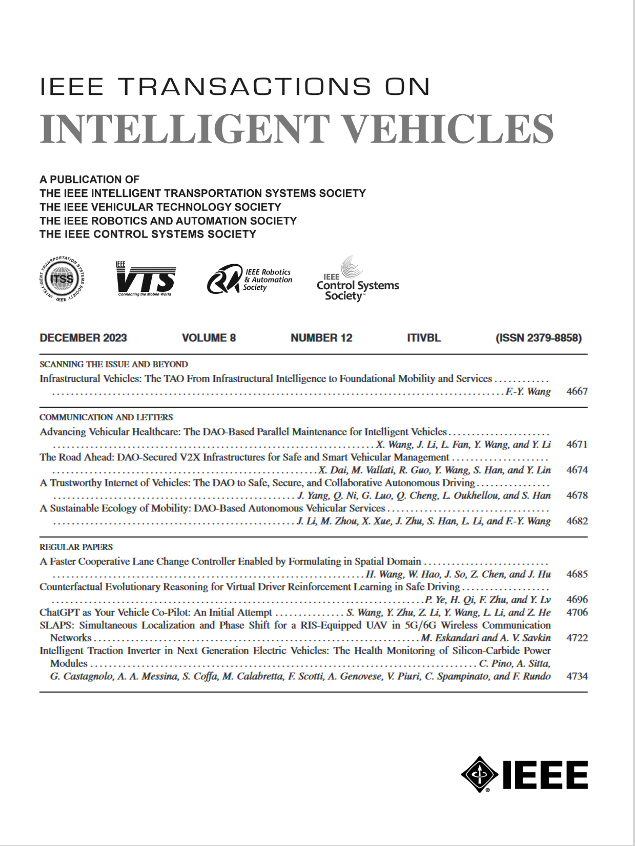噪声条件下增强态势感知的激光雷达数据过滤算法比较
IF 14.3
1区 工程技术
Q1 COMPUTER SCIENCE, ARTIFICIAL INTELLIGENCE
引用次数: 0
摘要
在雾、雨、烟和雪等恶劣天气条件下,激光雷达传感器数据可能会被噪音破坏,导致遗漏检测或误报。本文比较了几种最先进的激光雷达数据过滤技术,即半径离群值去除(ROR)、动态半径离群值去除(DROR)和低强度离群值去除(LIOR),通过评估它们在处理模拟噪声以及雾、烟和雨引入的现实噪声方面的性能。通过分析定义良好的性能指标进行比较,包括准确性、错误、精度、召回率和F-Score。我们的滤波结果表明,DROR滤波算法的整体性能优于ROR和LIOR滤波算法,但是,在特定的近距离LiDAR成像场景中,LIOR滤波算法的性能可以与DROR滤波算法相媲美。此外,本研究提出了一项新的尝试,利用不同密度的模拟噪声,以及雾和烟条件下引入的现实噪声,建立了ROR和DROR过滤技术的性能指标与最小相邻点数(Kmin)之间的关系。本文章由计算机程序翻译,如有差异,请以英文原文为准。
Comparison of LiDAR Data Filtration Algorithms for Enhanced Situational Awareness Under Noisy Conditions
In adverse weather conditions like fog, rain, smoke, and snow, LiDAR sensor data can become corrupted by noise, leading to missed detections or false positives. This paper presents a comparison of multiple state-of-the-art LiDAR data filtration techniques, namely Radius Outlier Removal (ROR), Dynamic Radius Outlier Removal (DROR), and Low Intensity Outlier Removal (LIOR), by evaluating their performance in addressing simulated noise, as well as realistic noise introduced by fog, smoke, and rain. The comparison is conducted by analyzing well-defined performance metrics, including, accuracy, error, precision, recall, and F-Score. Our filtration results indicate that overall performance of DROR is superior to both ROR and LIOR filtration algorithms, however, in specific short-range LiDAR imaging scenarios, the performance of LIOR can be comparable with DROR. Furthermore, this study presents a novel endeavor by establishing the relationship between performance metrics and minimum number of neighboring points (Kmin) for both ROR and DROR filtration techniques, utilizing different densities of simulated noise, as well as realistic noise introduced by foggy and smoky conditions.
求助全文
通过发布文献求助,成功后即可免费获取论文全文。
去求助
来源期刊

IEEE Transactions on Intelligent Vehicles
Mathematics-Control and Optimization
CiteScore
12.10
自引率
13.40%
发文量
177
期刊介绍:
The IEEE Transactions on Intelligent Vehicles (T-IV) is a premier platform for publishing peer-reviewed articles that present innovative research concepts, application results, significant theoretical findings, and application case studies in the field of intelligent vehicles. With a particular emphasis on automated vehicles within roadway environments, T-IV aims to raise awareness of pressing research and application challenges.
Our focus is on providing critical information to the intelligent vehicle community, serving as a dissemination vehicle for IEEE ITS Society members and others interested in learning about the state-of-the-art developments and progress in research and applications related to intelligent vehicles. Join us in advancing knowledge and innovation in this dynamic field.
 求助内容:
求助内容: 应助结果提醒方式:
应助结果提醒方式:


